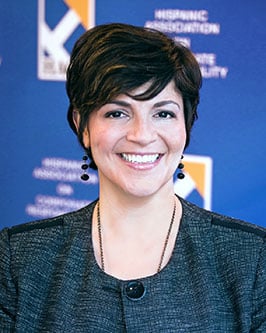What inspired this employee resource group (ERG) study to be done?
HACR, together with Dr. Rodriguez, saw an opportunity to fill a void for corporate America. There has been a great deal of attention paid to ERGs recently, however there was nothing that specifically focused on Hispanic ERGs. Our goal was to understand how companies and Hispanic professionals are leveraging these groups. HACR is an organization that’s interested in the way Hispanics are faring in corporate America, and that includes understanding why companies have these groups, why they are growing in popularity, how companies are utilizing them, and where their opportunities for growth are.

As you and Dr. Rodriguez conducted the study, what trends stood out?
What stood out the most was ERG growth and accomplishments in the community and in many cases the business. We often hear that as these groups continue to grow, companies are recognizing that they can play a vital role in terms of employment growth and business impact. But now corporations are starting to invest in ERGs in a way that is really meaningful—not just financially, but with talent, resources, training, etc.
There were a few companies that were ahead of the pack in providing resources and opportunities to their employees, but for the most part, this is a trend that’s catching on. Companies are also looking toward these groups to have an impact on their business development and initiatives, and that’s the direction we hope they all move in the future.
What, if any, results that came out of the study surprised you?
There were two things that I was surprised by: first, how vital these groups have become for employees’ continued development and growth within their companies and second, executive engagement. These groups are no longer just about social support, they are a way for employees to come together, impact their business if they are given that opportunity, and to serve as talent incubators for the next generation of Hispanic executives.
Were there any preconceived notions you had going into this study that turned out to be true?
I knew that companies wanted to learn how to better leverage their ERGs; their role in the business wasn’t being maximized to its potential. Companies want their ERGs to be involved, but most just haven’t completely figured out how to integrate them into business initiatives yet.
What value do you hope companies get out of this study?
The contribution of this study depends on where companies are in the ERG evolution cycle. For companies who are looking to start an ERG, the study provides a robust benchmark of where leading companies are (in terms of group size, resources provided, engagement with the community, and leadership development). For companies with existing ERGs, the report offers recommendations for their group to reach the next level of ERG development and growth. HACR, together with Dr. Rodriguez, has done a great job of providing tips for success and insights into Hispanic ERGs, which can only make them stronger.
Did you have any final thoughts about the ERG study you’d like to share?
The changing US demographics require companies to rethink how they’re doing business and how they are interacting with their own employees and consumers. This study was an important first step in that direction. It has deepened our understanding of the rising popularity of Hispanic ERGs and sparked conversation on a topic that is central for sustained growth and relevance in corporate America. Now is the time for corporations to leverage these insights and engage in these conversations so that they are well positioned in 2014 and beyond.
Hispanic ERGs By the Numbers
More than half of HACR’s survey respondents reported 500+ members in their Hispanic ERGs.
The average annual budget of Hispanic ERGs surveyed was $50,360.
93 percent of surveyed Hispanic ERGs reported increased visibility to corporate execs as a perk of ERG leadership.

